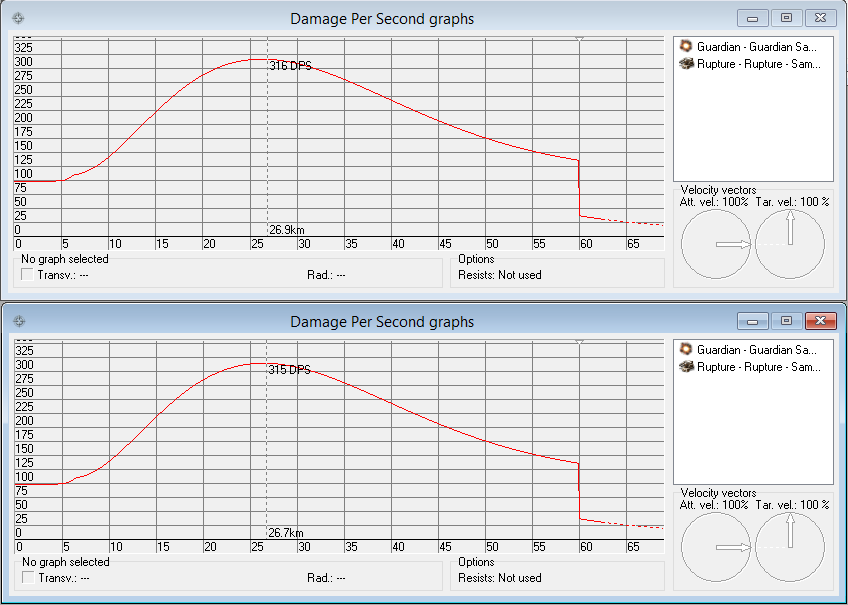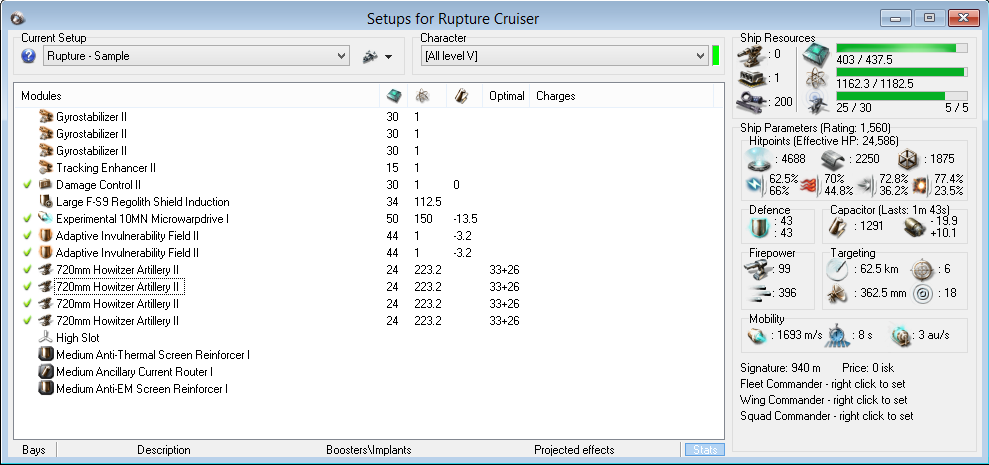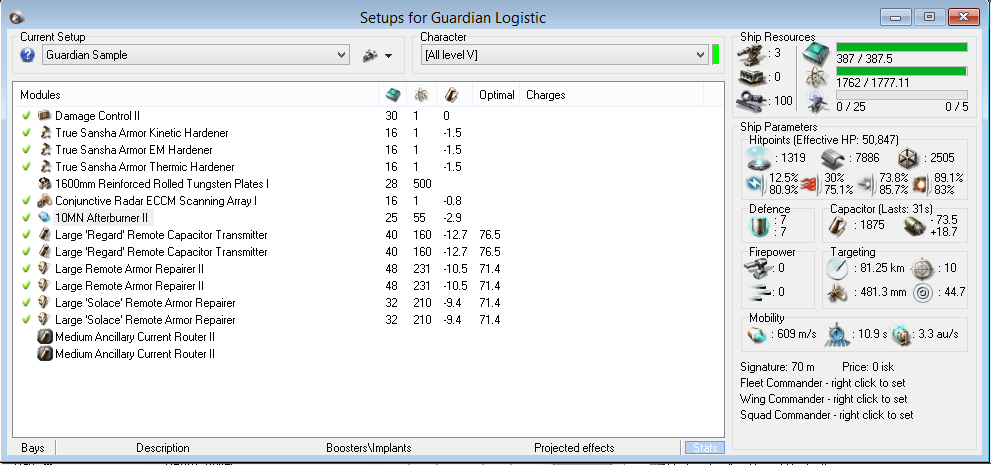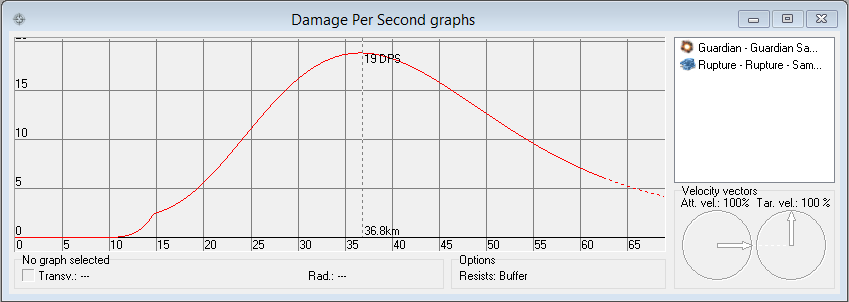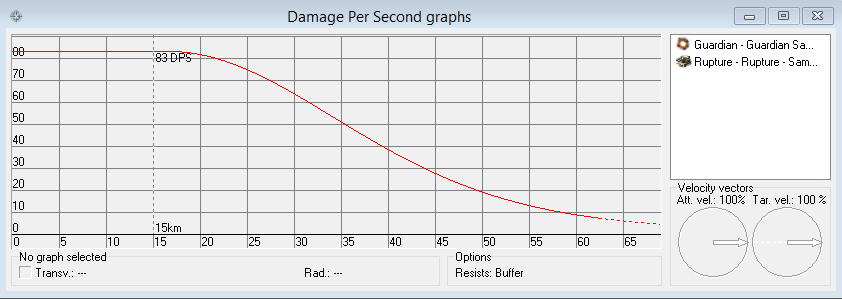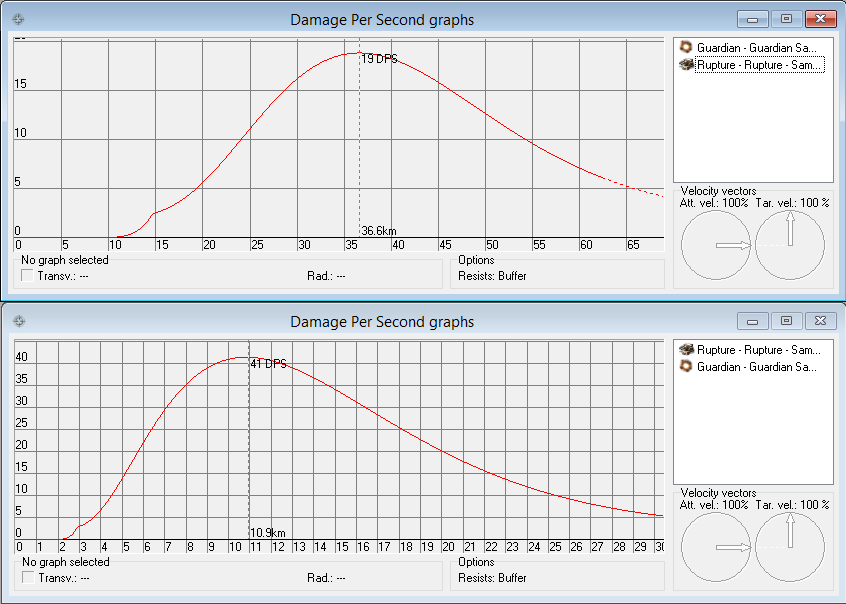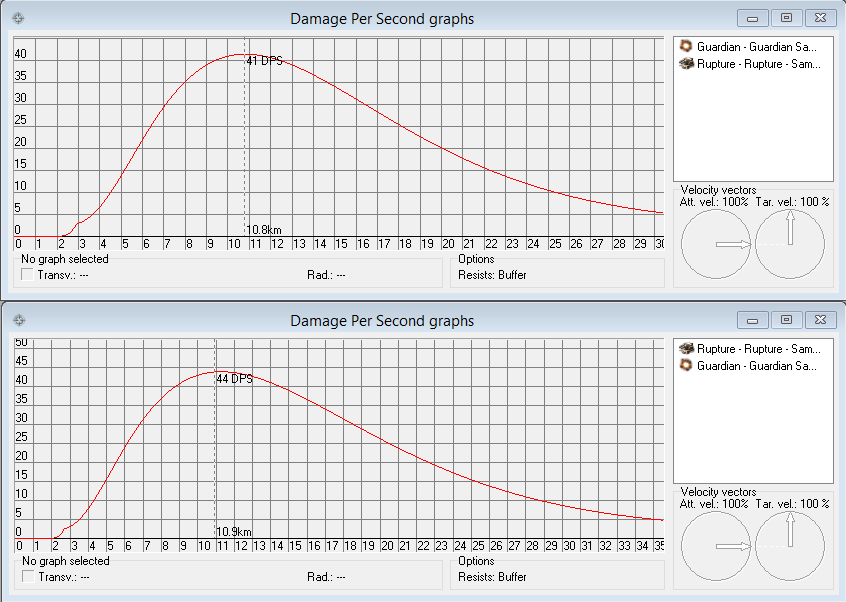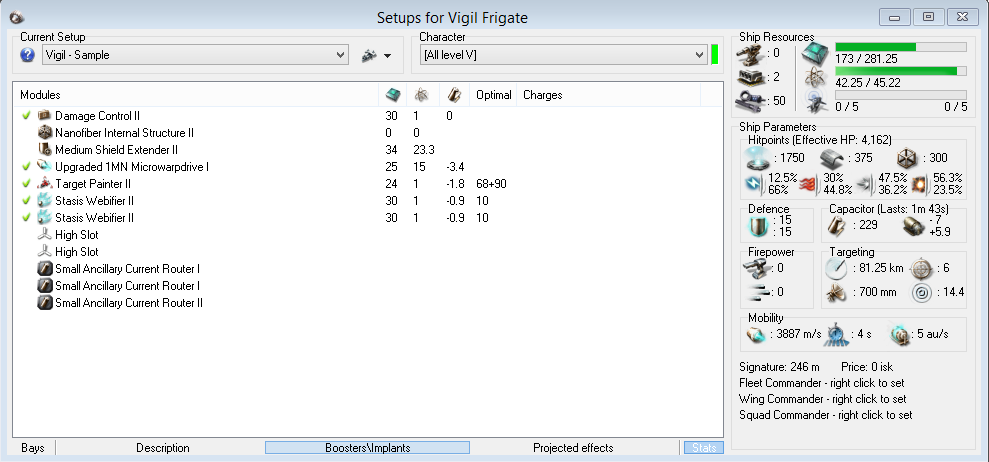Tomorrow will be the start of my third month in Eve, and I must say that I’ve had a blast so far. Winning and losing fights, destroying and losing ships, roaming, theorycrafting, and sperging up local has all been incredibly entertaining to me. One of the things I’ve found is that it’s very hard to find anything reliable in regards to Eve on the internet. Good resources are indeed out there, but even sources that most people regard as reputable contain incorrect information. For example, Eve University and the Eveonline Wiki both state that “you will be much easier to hit while running the MWD” and “MWD will increase [a] ship’s signature radius, making it easier to target and hit“, even though neither of these are necessarily true, provided you are A) not getting hit by missiles/bombs and B) are moving at your maximum MWD velocity while it’s activated? This is an oft-repeated piece of advice that I’ve heard almost universally, from vets and online resources alike, but a simple glance at the damage formula proves this to be not true. Since the MWD blows up your signature radius and speed evenly, you can see that the effects cancel out (again, assuming you’re moving at maximum velocity) in the formula.
Don’t believe me? Here’s a graph of a Guardian getting shot by a Rupture (and +5 Hobgoblins) with MWD on (top) and with MWD off (bottom).
But I digress. Recently, in Syndicate, my corporation’s been fighting with a few different entities down here. We always keep hitting a brick wall, though: we absolutely cannot deal with a fleet of Guardians that they continue to field. Even with my fleet of 40 Ruptures all firing within their optimal range with good ammunition selected, we were completely unable to phase the Guardians.
This has lead to a lot of talking and theorycrafting among people in my corporation, but ultimately it was necessary that we eventually take the plunge into EFT and figure out what’s going on. I’ll be cataloging the thought process in dealing with the enemy here. What follows is an analysis on the importance of applied damage and how little it matters what your numbers and DPS are if you can’t actually hit your enemy.
Here is our standard Rupture fit (with 5 Hobgoblins loaded):
This is what we’re assuming for the enemy’s Guardian fit, based on collected intel:
Knowing that Guardians are armor tanked (all of their repair modules are focused on replenishing armor), we can look and see that their weakest resists are EMP (80.9%) and Thermal (75.1%). Since there is no EMP/Thermal ammunition, we can look and see that the next weakest resist is Kinetic (83%). Now we have Proton (EM/Kinetic) and Phased Plasma (Thermal/Kinetic) to choose from, based on resistances. After comparing the two, I’ve decided to go with Phased Plasma, so we’ll be using the Faction version of that ammunition in our damage graphs.
I’m going to throw up the damage graph now of one of our Ruptures and we can immediately dispel a few bad trains of thoughts.
“But my DPS is really 355, I promise!”
There are a couple of tremendously important pieces of information that we can glean from this DPS graph.
- Optimal firing range (in this case, it’s 17 optimal + 26 fall-off) does not necessarily mean you are in optimal DPS range.
- You can have all the damage and alpha in the world, but if there are situations where you could be applying such a small % of it that it becomes irrelevant.
“Optimal range” vs actual optimal DPS range
To address the first point, let’s talk about “optimal range”.
In this particular case, you can see that our optimal DPS point doesn’t occur until about 37km away from our opponent, a good 20km into our fall-off.
This may seem confusing at first glance, but it makes sense when you begin to think about it. The closer the Guardian is to you the harder it will be for your turrets to track it. Moving at the exact same speed farther away from you means it will be easier to track. This brings me back to another rumor that I’ve heard a bit – “Transverse velocity is important to have on your overview!“ That’s actually not true at all, transverse velocity by itself means absolutely nothing. It’s the Angular that’s actually important! A ship that is moving 100m/s transverse to you that is right in front of your face is going to be a lot harder to track than a ship moving 100m/s 100km out from you.
To test that theory, let’s go ahead and change his velocity so that the Guardian is moving in a direct line away from us. If our previous theory is true, we should expect to see us applying our maximum damage up until we reach our fall-off.
Why can’t all Guardians fly like this?
EFT confirms what we should already know to be true.
“On paper” is irrelevant in some cases
The second point is probably the most painful realization. Ruptures flown with heavy artillery excel vs enemy logistics when they can alpha an enemy off the field. If you’re unable to alpha an enemy off the field, you can quickly find yourself completely useless as the enemy will simply repair any damage you do after your first volley and you will find yourself unable to destroy even a single enemy off the field.
Assuming we’re within our optimal DPS point, our DPS is 19. That is about 5.4% of our maximum DPS (what is listed in EFT on our build). That means our alpha damage of 2,638 has been reduced to a measly 141.2 damage per Rupture into their armor. If we take into account the shield/armor/hull of one of these Guardians (11,710), change EFT’s resists option to a “weighted average” (to account for different resists in the shield/hull), and then calculate out our Volley damage from there, that means we’ll need over 70 Ruptures (71.63, to be exact) in order to alpha one of these off the field, and that’s assuming every single Rupture is exactly in the optimal firing range and all fires at the exact same time.
So what are the problems we have to overcome when dealing with these Guardians?
- Tracking issues
- Active resists
Increasing tracking to increase damage
Let’s look at a few different possible solutions to deal with the tracking issues.
What if we throw autocannons onto a Rupture and compare the damage from there?
Sometimes smaller is better.
This actually results in a tremendous boost in DPS! Even though our ships’ DPS in EFT went up to 411 from 355 (a 15.8% increase), our effective DPS went up from 19 to 41 (a 116% increase)! Of course, it must be taken into consideration that we would have to fight them at considerably closer ranges than before. It’s also worth noting that our optimal damage range is far from within our optimal range listed on our autocannons as well.
What if we replace a gyrostabilizer (damage module) for another tracking enhancer (a tracking module) while keeping our autocannons?
3 gyros/1 tracking on top, 2 gyros/2 tracking on bottom.
It’s not a huge increase in damage (41->44 is about a 7% increase), but it’s worth noting that our “on paper” DPS in EFT fell from 411 to 366, even though our actual applied damage increased.
Excluding drones, it seems as though this is about the best we can do for damage against these Guardians. Adding another tracking enhancer hurts us more than it helps us, and there aren’t really any other modifications we can make to our ships to increase our damage. Still, though, we were able to take our damage from 19 DPS to 44 DPS, a respectable 132% increase in damage, and all we had to do was switch up a couple of mods on our Ruptures. Unfortunately, this doesn’t help the alpha situation too much as autocannons have significantly less volley damage than artillery. It is possible, unless the enemy responds perfectly, to get two shots off before a single rep can finish, though, as autocannons take 2.32 seconds to fire and the fastest guardian rep takes 4.5 seconds to complete, ignoring overload bonuses.
This means, assuming every Rupture fires twice, perfectly, it would now take 49 (48.4, to be exact) Ruptures firing two cycles of autocannon shots to take a Guardian off the field. Way better than the 72 required before, but still not as nice as I’d like it to be. Now of course no one simply flies 30-40 Ruptures in space with no back-up or assistance, so it’s time to look at using other ships to amplify the damage we can deal. I’d like to introduce now our new friend, the Vigil.
“Slow the fuck down!” the Vigil says to the Guardian.
I loaded up all of the info into EFT and I tried a combination of 3 target painters/0 webs, 2 target painters/1 webs, 1/2, and 0/3, and it turned out that the best damage came from using two webifiers and one target painter. Just how much of a difference can a single Vigil make? Let’s compare two Guardians, one with two webs and a target painter on him. We’ll stick to our autocannon rupture as well.
Webbed/Painted Guardian on the bottom.
Wow! Now we see a massive increase in damage. A single vigil just raised the DPS of our entire fleet from 44 to 80, an 82% increase in damage for every single Rupture from just a single ship! Even more exciting? The DPS of our Ruptures just increased to 77! Looking at the weighted average of the resists of the Guardian and using our vigil + Rupture artillery fleet, it looks like we can now alpha a single Guardian off the field with only 18 Ruptures!
Now we’re moving into fighting territory. With only 18 Ruptures being required to alpha off a Guardian from the field, 30-40 should be able to easily do it, even accounting for people not being within optimal range and with other mistakes being made.
Dealing with active resists
Is the Vigil the ultimate solution, then, to our problems? Let’s take a look at another possible solution: energy neutralizers.
There are some ships that neutralize energy very well (Armageddons and Bhaalgorns), but none of them really fit in with a shield-tanked fleet, unfortunately. I know that the Curse is an option as well, but we’re currently not capable of fielding enough of them to make it worthwhile. But let’s say we did have the ability to neutralize the energy of one of these Guardians, what would the damage look like from one of the artillery Ruptures?
600% increase in damage? Yes, please!
Ahh, now we’re talking. So let’s take a look at what’s going on here. We’ve neutralized out the Guardian, meaning we’ve eliminated all three active hardeners + the afterburner. Their resists have fallen and their speed and transverse has fallen to such a point that our applied damage increases to insane amounts.
If we were able to neutralize a Guardian and the Guardian transferring capacitor to him and then fire a volley off before the hardeners were re-activated, our damage would increase 584%! We would only need 15 Ruptures at this point to take out a vulnerable Guardian on the field!
Unfortunately, neuting out Guardians to drop their resists is very, very hard. The hardeners run for 20 additional seconds after they’ve been activated, plus other Guardians could join in to transfer capacitor to the neuted Guardian. This makes me shy away from neuting a bit, at least when you’re dealing with 10+ Guardians.
Just running through some other math for fun – if you had a Guardian neuted out completely, with two webs and one painter on him, you could alpha him off the field with only 9 Ruptures.
Much like measuring horsepower at the crankshaft vs horsepower put to the ground, it’s very important to look at the difference between how much damage you’re capable of dealing vs how much damage you’re actually dealing. I hope you’ve enjoyed my simple journey through EFT. If the reception is good, I’ll look to post additional material here as I continue to run into problems.
